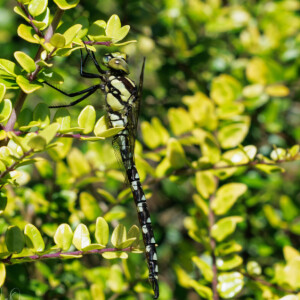Spiky
While R and I were working in the garden this morning there were three Southern Hawkers hunting around us - two males and a female. One of the males was showing mature colouration, the female slightly less so (making her a different individual to the one I photographed yesterday), and the male I've posted as tonight's extra was so pale he was probably no more than twenty four hours old. If I hadn't happened to see him come down in the lonicera I doubt I'd have noticed him there, so beautifully did he blend in with the foliage. Realising that I'd seen him, he carefully bent up his abdomen and moved it to the far side of the bottom shoot, and then shifted his grip on the top one so that his body moved behind the one in the middle. The shadows thrown by the shoots gave him extra camouflage, and he disappeared almost completely.
I went back to work, but kept an eye on him, and was interested to see that he hung there for over an hour before moving on. Maybe he was simply resting, but it's also quite likely that he was staying out of the way of the mature male, so as not to have to fight a fitter and stronger opponent. It never fails to amaze me that dragonflies emerge from their watery larval existence apparently fully equipped with the knowledge they need to master their brief airborne lives.
I'd fully expected to be featuring the Southern Hawker tonight, right up until the moment this afternoon when I realised that there were two fresh Wool Carder bees working around our biggest patch of hedge woundwort. As I've been hunting Wool Carders for nearly four weeks now without success, I was determined to get at least record shots of this pair, and though it took half an hour and a very large number of shutter clicks, in the end I managed it. This is a male, shown clearly here by the four vicious spines at the end of his abdomen, with which he will try to kill any rival entering his territory, by bending his abdomen and crushing the enemy against the underside of his thorax.
The second individual was a female, who seemed to alternate between flaunting herself on various leaves as though she was looking for a mate, and dematerialising the second the male put in an appearance, so he was left zooming around the plants in a fruitless and ever more frustrated search. If she wasn't convinced that she wanted to meet him, I can't say I blame her: Wool Carder copulation is a pretty brutal affair, and unlike many other species of solitary bee, the females don't get to do it just once and then rebuff any other male who comes their way, so I guess they do need to be in the mood. Presumably though, the urge to fulfil the biological imperative and pass on their DNA must win out in the end.
By the way, if I can't see a spiky bum, my mnemonic for distinguishing male and female Wool Carders is that the males are hairier, with extravagant white fringing along the sides of their bodies and down their legs. Coupled with the fact that their tarsi and the lower ends of their tibiae are pale, this white hair makes them look as if they're wearing long white baseball socks. Females also have white hair, but it's sparser along their bodies and shorter on their legs. It's quite dense and rather yellow around the tarsi, giving them a thickened appearance that puts me in mind of the 1980s fashion for legwarmers. Males are also quite a lot bigger than females - maybe 15mm in length compared with 11mm, and more heavily built - but obviously this is only helpful information if you can compare them with each other, or with something else of a known size.


Comments
Sign in or get an account to comment.


